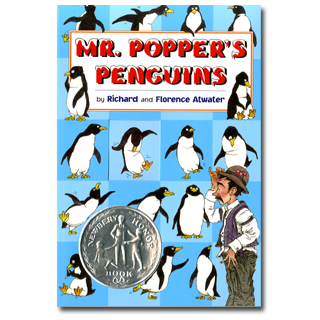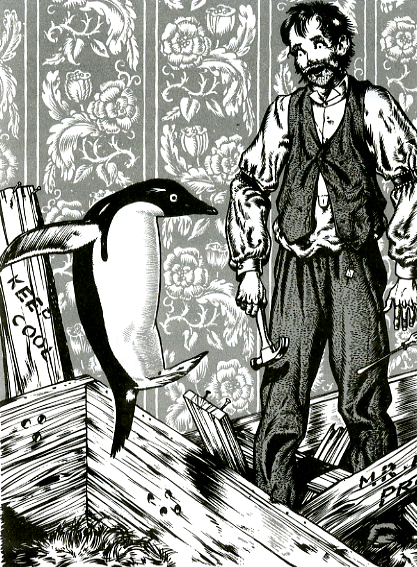
A FEW OTHER EVENTS FOR
DECEMBER 29:
- Happy birthday Molly Garrett Bang (Ten, Nine, Eight, When Sophie Gets Angry—Really, Really Angry).
- It’s the birth date of E.W. Hildick (1925–2001) The Case of the Absent Author, Birdy Jones.
- Happy birthday Texas, which became the 28th U.S. state in 1845.
- In 1851, the first American YMCA opens in Boston, Massachusetts.
- It’s Tick Tock Day, in terms of the days of this current year are running out. Read Tick Tock by Lena Anderson; The House with the Clock in its Walls by John Bellairs, illustrated by Edward Gorey; and The Thirteen Clocks by James Thurber.
Today marks the birthday of Richard Atwater, born in 1892. He graduated with honors from the University of Chicago, where he taught Greek. But for most of his career, Atwater worked as a journalist, book review editor, and columnist for newspapers. He dabbled in publishing—first he wrote an opera, then a children’s book Doris and the Trolls, both now long forgotten. But then after seeing a motion picture about Richard Byrd’s first Antarctic expedition, Atwater wrote another story—about a man who fell in love with the birds of this snowy continent—Mr. Popper’s Penguins.
Sometimes talented husband-and-wife teams—H.A. and Margret Rey or Crockett Johnson and Ruth Krauss—intentionally work together on a book. In the case of Richard and Florence Atwater, their collaboration grew out of necessity. After attending University of Chicago, Florence Carroll married Richard Atwater in 1921. When her husband had a stroke, she needed to support the family and published pieces in The New Yorker and The Atlantic. After two publishers turned down her husband’s Mr. Popper’s Penguins manuscript, she edited and rewrote sections, adding a bit more reality to a very fanciful story. When she sent it to Little Brown & Company, she wrote: “I know that so-called progressive education assumes that the modern chld must live entirely in a world of cold reality. Nevertheless, my own 11-year-old daughter, who reads everything, complains so loudly about the number of juveniles with a pioneer American background, that I wonder whether other children might not be entertained by our penguins.” Other children were; the novel won a Newbery Honor and has stood the test of time.
Ideal for seven- to ten-year-old children who have just mastered reading skills, Mr. Popper’s Penguins features a house painter, a Walter Mitty dreamer who wants to travel particularly to the North and South Poles. Mr. Popper even writes to his hero, Admiral Drake, currently exploring Antarctica. Then, unexpectedly, the admiral sends him a gift—a penguin, given the name Captain Cook, who comes to live with the Poppers and completely transforms their lives. Although the story rests firmly on nonsense, it is related with such a matter-of-fact style that it all seems plausible. Mr. Popper remodels his house to create an ideal environment for Captain Cook. He has holes drilled in the refrigerator so the Captain can live there. After a female penguin arrives, and they have ten children, the troop of twelve travels the United States as a performing act.
There are no lessons here or morals, just fun and nonsense. Robert Lawson, who can delineate character brilliantly with only black line, provided fabulous drawings of all the penguins and their antics. They look so real you can almost believe these events are happening. If anyone in your family is suffering from post-holiday blues, pick up Mr. Popper’s Penguins in honor of both Richard and Florence Atwater. For 140 pages you will be reminded of one of the truths about our classic children’s books: no matter what is going on in reality, they make us happy while we stay within their pages.
Here’s a passage from Mr. Popper’s Penguins:
Captain Cook was now attending to the picking up.
Into the corners of every room he prowled and poked and pecked with a busy thoroughness; into every closet he stared with his white-circled eyes; under and behind all the furniture he crowded his plump figure, with little subdued cries of curiosity, surprise, and pleasure.
And each time he found what he seemed to be looking for, he picked it up in the black end of his red beak, and carried it, waddling proudly on his wide, pink feet, into the kitchen, and into the icebox.
Originally posted December 29, 2010. Updated for .














A good chunk of my childhood was spent playing school and library in my bedroom. My bedroom looked like an elementary school classroom: chalk board, teacher’s desk, textbooks, office supplies, etc. Mr. Popper’s Penguins was my favorite book to read aloud to my imaginary students. I read it at least 10 times. Therefore, it was not surprising when I read it aloud to my first group of third graders.
Thank you for your daily recommendation.
John: I can completely identify with your story. I taught school to my stuffed animals — and many of them excelled in reading! Anita
Puff, puff. I’m trying to keep up by reading the books reviewed here that I haven’t read already. I have three coming to my branch library as I type.
I have a great relationship with my branch librarians, and I discuss these selections several times a week with our children’s specialist. When I first started 100 Best Books for Children, she liked what I was doing so much, and my enthusiasm about it, that she bought Anita’s book for herself.
Also, I loved Lawson’s Rabbit Hill ,which I learned about from Anita..
It’s really a lot of fun reading these reviews each day.
How interesting to read you post regarding this book. I had a teacher reading it with her students right before the break and mentioned how great it is. Unfortunately, as a media specialist/librarian it is one I have not yet read so I brought it home to read over the break. It is getting closer to the top of the pile. Thanks for the background info. I really enjoy your site!
This was the very first book I read twice! Although I had plenty of reading material around my house as soon as I got to the last page I went right back to the first one.
I’m a big believer in the tactile experience of reading, so I waited to read this book until I could find a nice, sturdy hardcover edition that I could snuggle in bed with. Once I did, I marveled over the Robert Lawson illustrations and fell in love with the Poppers, especially the overly tolerant Mrs. Popper. I agree with Anita–this book really chases away the post-holiday blues and makes you wish for a snow day, so you can stay in bed and read this book again.
Could you please add Florence Carroll Atwater’s name under the title. Thank you!
Her granddaughter
Of course, sorry for the oversight. And how pleased you must be to know that this wonderful book was written by your grandmother and grandfather.
Thanks so much Anita for this fascinating back story on MR. POPPER’S PENGUINS. How I loved that book! Florence Atwater’s role in tying the story to an everyday, fairly drab reality made the implausible totally plausible. And Robert Lawson’s illustrations brought the story another dimension. The pictures show the prosaic world of the depression, when it was published, and prove that dreams can come true. (I was convinced that I, too, could create an ice slide like the one in the book, should penguins happen to arrive in the mail.) I’m glad the book has stood the test of time and become a classic. I’m also glad that no publisher has felt a need to bring it up to date with trendy. more hip illustrations. And glad that you’re refreshing the memories of those of us who had never forgotten their first readings of this book, and tempting new readers who have yet to enjoy it.
Here is another book I read after last year’s review and didn’t get to comment on.
As Anne Rockwell says, Robert Lawson’s artwork clearly suggest a simpler time in our past. I love Lawson’s art and his books.
I listened to this book on unabridged CDs and found it a joy to listen to. One’s imagination is filled with possibility of things you’ve dreamed of doing yourself, just like Mr. Popper.
A comment by Jamie Tan (above) about tactile experience, resonates strongly with me. I love books that are well made, have excellent type choices, great paper, and art. That is one thing I like about The Library of America books, great craftsmanship, because holding a book like that in your hand which contains great writing is one of life’s supreme experiences.
Gordon: Thanks for the comment. I certainly agree with you and Jamie about book craftsmanship. A few months ago, I saw a first edition of this title. How I wish the publishers would reissue it! in its original form. To begin with, all the art had one color (a beautiful blue), and the printing was devine. Even for this Depression Era book, Little Brown knew they had a gem on their hands and went the extra mile to make it perfect to give as a gift.
Sometime around 1962 (I’m guessing), the Wilmette (Illinois) Children’s Theatre (sorry, that’s how they spell it) put on “Mr. Popper’s Penguins” as their summer production, and I played one of the penguins, in a very hot vinyl penguin suit. I’d loved the story before that, but all the more so afterwards. And Robert Lawson had already been one of my favorite author/illustrators.
Paul: I can actually see you as a penguin! I bet you did a great job.
I have an especially warm spot in my heart for Mr. Popper. Many years ago a usually 10 minute bus ride morphed into almost an hour because of a snowstorm. Luckily I had Mr. Popper with me or my almost 5 year old who did not like crowds would have made everyone’s life even more miserable crying to get off. I started reading and just kept going, not realising I was apparently reading to the whole trapped busload of commuters. I had just reached the last chapter where Mr. Popper has to make his decision. As we got ready to get off the bus I told my dughter we would just have to find out what Mr. Popper decided on the way home. All of a sudden from the back of the bus comes a plaintive voice “But we won’t be here on the way home!” Which is when I realized I had been using my “storyhour voice” and had been apparently reading to the whole bus.
Julie: Thanks for sharing this — great story.
Julie, that story is so wonderful, it’s a book in itself. I think having story hour on commuter buses and trains is a great idea!